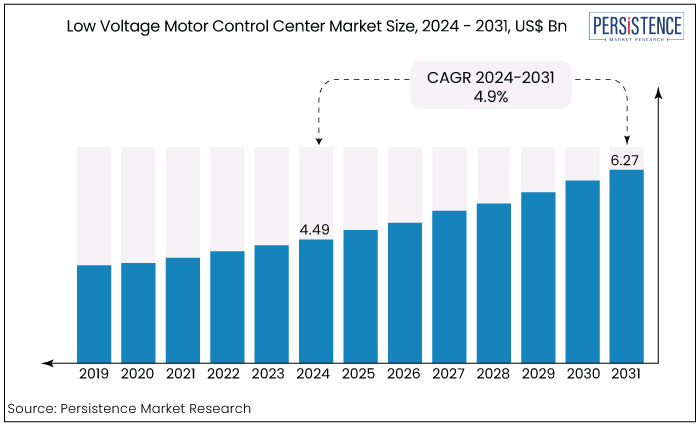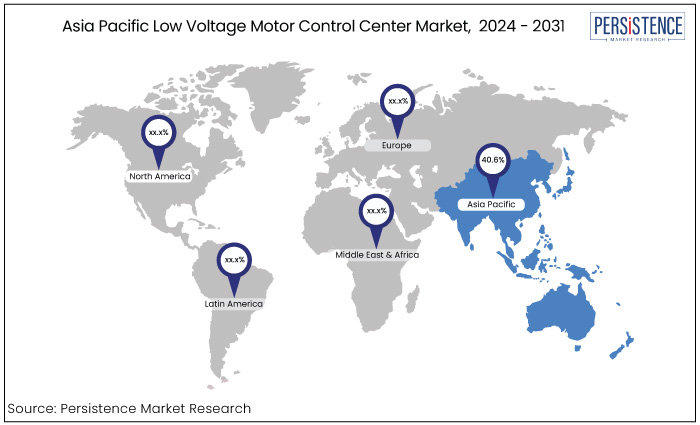Industry: Industrial Automation
Published Date: September-2024
Format: PPT*, PDF, EXCEL
Delivery Timelines: Contact Sales
Number of Pages: 164
Report ID: PMRREP34785
The low voltage motor control market is estimated to increase from US$4.49 Bn in 2024 to US$6.27 Bn by 2031. The market is estimated to record a CAGR of 4.9% during the forecast period from 2024 to 2031. As automation becomes more prevalent across different industries, the need for low-voltage motor control centers is anticipated to rise. These centers play a crucial role in streamlining processes and minimizing downtime, making them essential for efficient automated operations.

Key Highlights of the Market
|
Attributes |
Key Insights |
|
Market Size (2024E) |
US$4.49 Bn |
|
Projected Market Value (2031F) |
US$6.27 Bn |
|
Global Market Growth Rate (CAGR 2024 to 2031) |
4.9% |
|
Historical Market Growth Rate (CAGR 2019 to 2023) |
4.7% |
|
Region |
Market Share in 2024 |
|
Asia Pacific |
40.6% |
Asia Pacific low voltage motor control center market is expected to hold a 40.6% share. Significant investments in infrastructure and manufacturing along with rising automation in industries such as automotive, chemicals, and oil & gas, fuel market growth.
The region's focus on energy efficiency and sustainability encourages the adoption of advanced MCC systems. Increased competition among local and international companies’ fosters innovation and lowers costs. Government policies supporting industrial modernization further accelerate expansion boosting demand for sophisticated MCC systems with improved monitoring and control capabilities.

North America market is poised for continuous growth during the forecast period with the U.S. and Canada leading due to significant investments in manufacturing, oil & gas, and infrastructure. The rise of automation and smart manufacturing drives demand for advanced motor control solutions that boost efficiency.
A strong emphasis on energy efficiency and sustainability promotes modern MCC systems, optimizing energy use and reducing costs. Additionally, robust power distribution networks and renewable energy deployments enhance market demand. Advancements in IoT and AI support next-generation solutions ensure North America's leadership in the global MCC market.
|
Category |
Market Share in 2024 |
|
Type - Conventional Motor |
66.8% |
As per the low voltage motor control center market update, conventional motor is expected to dominate the market with a 66.8% revenue share in 2024 which is favored for their reliability and cost-effectiveness across industries. Their familiar design allows for easy installation and maintenance by electrical personnel, although they may lack the advanced, data-driven features sought in modern applications.
|
Category |
Market Share in 2024 |
|
Component - Busbars |
23.5% |
PMR's low voltage motor control center market forecast shows that busbars are poised to capture large market share of 23.5%, serving as essential component in MCCs for effective power distribution. Their crucial role in ensuring safe and reliable power delivery, alongside advancements like phase segregation and insulated enclosures reinforces their dominance.
Busbars offer a more efficient and reliable method of distributing electrical power compared to traditional wiring. Their design minimizes energy losses and enhances the overall performance of motor control centers.
Busbars allow for more compact and organized designs, which is advantageous in the confined spaces typical of many MCC setups. This compactness can lead to more efficient use of space and better overall system management.
The industry is growing rapidly and is expected to reach a notable CAGR in upcoming years. Low voltage motor control centers (MVCs) are essential components in industrial and commercial electrical systems, primarily designed to control and manage electric motors operating at voltages up to 1000V.
These centers serve as a centralized hub for the control, monitoring, and protection of motor-driven applications, facilitating efficient operation and maintenance. They comprise a combination of motor starters, protection devices, and control elements, all housed within a compact enclosure.
The industry is currently experiencing significant growth driven by several low voltage motor control center market trends. The growing emphasis on automation and digitization in manufacturing processes is bolstering the adoption of smart MVCs equipped with IoT capabilities, enabling real-time monitoring and remote management.
The push for sustainable practices and compliance with stringent regulations regarding energy consumption and emissions is driving companies to upgrade their existing infrastructure to incorporate low voltage MVCs. Furthermore, the rise of renewable energy sources and electric vehicles is creating new opportunities for MVC manufacturers to innovate and tailor solutions that cater to evolving market needs.
The low voltage motor control center market analysis has shown steady growth over the past few years with a CAGR of 4.7% from 2019 to 2023. This growth can be attributed to the increasing demand for efficient motor control solutions across various industries, including manufacturing, oil and gas, and water treatment.
As industries continue to prioritize automation and energy efficiency, the adoption of MVCs has become essential for optimizing operational performance and reducing energy costs.
The market growth is projected to maintain a robust growth trajectory with an anticipated CAGR of 4.9% from 2024 to 2031. This upward trend is expected to be driven by several factors including advancements in technology, the integration of smart features in MVCs, and the growing emphasis on sustainable practices.
As industries increasingly adopt digital solutions and IoT technologies, the demand for intelligent motor control systems that offer real-time monitoring and predictive maintenance capabilities is likely to rise. Furthermore, the ongoing investments in infrastructure development and the expansion of renewable energy sources will further bolster the MVC market.
Increasing Demand for Energy Efficiency
The growing emphasis on energy efficiency across various industries is a significant driver for the low voltage motor control center market growth. Companies are increasingly seeking solutions that minimize energy consumption and reduce operational costs.
Low voltage MVCs are designed to optimize motor performance, allowing for better energy management and lower electricity bills. As industries face rising energy costs and strict regulations on energy use, the adoption of energy-efficient MVCs becomes essential. This trend is particularly evident in sectors such as manufacturing, where operational efficiency is paramount.
Advancements in Automation and Smart Technologies
The rapid advancement of automation and smart technologies is transforming market demand. Industries are increasingly integrating IoT capabilities into MVCs, enabling real-time monitoring, predictive maintenance, and remote control of motor operations.
Shift towards smart MVCs enhances operational efficiency and reduces downtime, making them highly attractive to manufacturers. As businesses strive for great automation to improve productivity and reduce labor costs, the demand for intelligent motor control solutions is expected to rise significantly driving market growth.
Expansion of Infrastructure and Renewable Energy Projects
The ongoing expansion of infrastructure and renewable energy projects is another key growth driver for the low voltage motor control center market expansion. As governments and private sectors invest significantly in infrastructure development, the need for reliable motor control solutions in construction, transportation, and energy sectors increases.
The shift toward renewable energy sources such as wind and solar power necessitates efficient motor control systems to manage various applications, including pumps and fans. This trend not only supports the growth of MVCs but also aligns with global sustainability goals, further enhancing market prospects.
Lack of Skilled Manpower
One of the significant factors restraining the growth of the low voltage motor control center market is the lack of skilled manpower. As industries increasingly adopt advanced technologies and automation, the demand for qualified personnel who can design, install, and maintain these systems has surged.
There is a notable shortage of trained professionals with the necessary expertise in electrical engineering and motor control systems. This skills gap can lead to delays in project implementation, increased operational costs, and difficulties in maintaining optimal performance, ultimately hindering market growth.
Absence of Standardization and Protocols
The absence of standardized protocols and regulations hinders low voltage motor control center market sales and poses another significant impediment. Without universally accepted standards, manufacturers may face challenges in ensuring compatibility and interoperability among different MVC systems.
Lack of standardization can lead to increased costs for companies that need to customize solutions to fit specific requirements. Additionally, it may result in safety concerns and inefficiencies in operations, as varying quality levels and practices can affect the reliability of motor control systems. Consequently, this uncertainty can deter potential investments in MVC technologies.
Integration with IoT and Smart Technologies
The increasing integration of Internet of Things (IoT) and smart technologies presents a significant opportunity for the growth of the low voltage motor control center market. By incorporating IoT capabilities, MVCs can offer real-time monitoring, data analytics, and remote management functionalities.
Shift toward smart MVCs not only enhances operational efficiency but also reduces downtime and energy consumption, making them more attractive to businesses. As industries increasingly embrace digital transformation, the demand for intelligent motor control solutions is expected to surge, driving market growth.
Expansion in Renewable Energy Applications
The ongoing global transition toward renewable energy sources provides various low voltage motor control center market opportunities. As investments in solar, wind, and other renewable energy projects increase, the need for efficient motor control systems to manage various application such as pumps, fans, and generators will rise significantly.
Low voltage MVCs can play a crucial role in optimizing these systems ensuring reliable and efficient energy generation and distribution. This alignment with sustainability goals and the growing focus on green technologies will create new avenues for innovation and market expansion in the coming years.
The market is witnessing significant growth reflecting its dynamic nature. Industry players are launching new products and integrating innovative technologies to create new opportunities within the sector.
Companies are adopting critical business strategies to broaden their product lines, increase market shares across different regions, invest in research and development, expand internationally, and enhance supply chains to boost market value.
Recent Developments in the Low Voltage Motor Control Center Market
|
Attributes |
Details |
|
Forecast Period |
2024 to 2031 |
|
Historical Data Available for |
2019 to 2023 |
|
Market Analysis |
US$ Billion for Value |
|
Key Countries Covered |
|
|
Key Market Segments Covered |
By Component
|
|
Key Companies Profiled |
|
|
Report Coverage |
|
|
Customization & Pricing |
Available upon request |
By Component
By Type
By Region
To know more about delivery timeline for this report Contact Sales

The market is predicted to rise from US$ 4.49 Bn in 2024 to US$ 6.27 Bn by 2031.
A few of the leading industry participants are ABB, Mitsubishi Electric, Siemens, and Schneider Electric.
The market is estimated to record a CAGR of 4.9% during the forecast period.
Conventional motor is a leading segment and is expected to dominate industry accounting for 66.8% share in 2024.
Asia Pacific leads in the industry and to hold a 40.6% share in 2024.